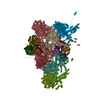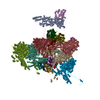[English] 日本語
 Yorodumi
Yorodumi- PDB-8tet: Human cytomegalovirus portal vertex, non-infectious enveloped par... -
+ Open data
Open data
- Basic information
Basic information
| Entry | Database: PDB / ID: 8tet | ||||||||||||||||||||||||||||||
|---|---|---|---|---|---|---|---|---|---|---|---|---|---|---|---|---|---|---|---|---|---|---|---|---|---|---|---|---|---|---|---|
| Title | Human cytomegalovirus portal vertex, non-infectious enveloped particle (NIEP) configuration 1 (NC1) | ||||||||||||||||||||||||||||||
 Components Components |
| ||||||||||||||||||||||||||||||
 Keywords Keywords |  VIRUS / tegument / portal / VIRUS / tegument / portal /  DNA packaging / DNA packaging /  intracellular transport intracellular transport | ||||||||||||||||||||||||||||||
| Function / homology |  Function and homology information Function and homology informationhost cell viral assembly compartment / T=16 icosahedral viral capsid /  viral tegument / viral DNA genome packaging / viral tegument / viral DNA genome packaging /  viral capsid assembly / host cell cytoplasmic vesicle / chromosome organization / viral release from host cell / viral process / viral penetration into host nucleus ...host cell viral assembly compartment / T=16 icosahedral viral capsid / viral capsid assembly / host cell cytoplasmic vesicle / chromosome organization / viral release from host cell / viral process / viral penetration into host nucleus ...host cell viral assembly compartment / T=16 icosahedral viral capsid /  viral tegument / viral DNA genome packaging / viral tegument / viral DNA genome packaging /  viral capsid assembly / host cell cytoplasmic vesicle / chromosome organization / viral release from host cell / viral process / viral penetration into host nucleus / viral capsid assembly / host cell cytoplasmic vesicle / chromosome organization / viral release from host cell / viral process / viral penetration into host nucleus /  viral capsid / symbiont-mediated perturbation of host ubiquitin-like protein modification / viral capsid / symbiont-mediated perturbation of host ubiquitin-like protein modification /  ubiquitinyl hydrolase 1 / cysteine-type deubiquitinase activity / host cell cytoplasm / ubiquitinyl hydrolase 1 / cysteine-type deubiquitinase activity / host cell cytoplasm /  Hydrolases; Acting on peptide bonds (peptidases); Cysteine endopeptidases / host cell perinuclear region of cytoplasm / symbiont entry into host cell / host cell nucleus / structural molecule activity / Hydrolases; Acting on peptide bonds (peptidases); Cysteine endopeptidases / host cell perinuclear region of cytoplasm / symbiont entry into host cell / host cell nucleus / structural molecule activity /  proteolysis / proteolysis /  DNA binding DNA bindingSimilarity search - Function | ||||||||||||||||||||||||||||||
| Biological species |    Human herpesvirus 5 strain AD169 Human herpesvirus 5 strain AD169 | ||||||||||||||||||||||||||||||
| Method |  ELECTRON MICROSCOPY / ELECTRON MICROSCOPY /  single particle reconstruction / single particle reconstruction /  cryo EM / Resolution: 4.26 Å cryo EM / Resolution: 4.26 Å | ||||||||||||||||||||||||||||||
 Authors Authors | Jih, J. / Liu, Y.T. / Liu, W. / Zhou, H. | ||||||||||||||||||||||||||||||
| Funding support |  United States, 9items United States, 9items
| ||||||||||||||||||||||||||||||
 Citation Citation |  Journal: Sci Adv / Year: 2024 Journal: Sci Adv / Year: 2024Title: The incredible bulk: Human cytomegalovirus tegument architectures uncovered by AI-empowered cryo-EM. Authors: Jonathan Jih / Yun-Tao Liu / Wei Liu / Z Hong Zhou /  Abstract: The compartmentalization of eukaryotic cells presents considerable challenges to the herpesvirus life cycle. The herpesvirus tegument, a bulky proteinaceous aggregate sandwiched between ...The compartmentalization of eukaryotic cells presents considerable challenges to the herpesvirus life cycle. The herpesvirus tegument, a bulky proteinaceous aggregate sandwiched between herpesviruses' capsid and envelope, is uniquely evolved to address these challenges, yet tegument structure and organization remain poorly characterized. We use deep-learning-enhanced cryogenic electron microscopy to investigate the tegument of human cytomegalovirus virions and noninfectious enveloped particles (NIEPs; a genome packaging-aborted state), revealing a portal-biased tegumentation scheme. We resolve atomic structures of portal vertex-associated tegument (PVAT) and identify multiple configurations of PVAT arising from layered reorganization of pUL77, pUL48 (large tegument protein), and pUL47 (inner tegument protein) assemblies. Analyses show that pUL77 seals the last-packaged viral genome end through electrostatic interactions, pUL77 and pUL48 harbor a head-linker-capsid-binding motif conducive to PVAT reconfiguration, and pUL47/48 dimers form 45-nm-long filaments extending from the portal vertex. These results provide a structural framework for understanding how herpesvirus tegument facilitates and evolves during processes spanning viral genome packaging to delivery. | ||||||||||||||||||||||||||||||
| History |
|
- Structure visualization
Structure visualization
| Structure viewer | Molecule:  Molmil Molmil Jmol/JSmol Jmol/JSmol |
|---|
- Downloads & links
Downloads & links
- Download
Download
| PDBx/mmCIF format |  8tet.cif.gz 8tet.cif.gz | 2 MB | Display |  PDBx/mmCIF format PDBx/mmCIF format |
|---|---|---|---|---|
| PDB format |  pdb8tet.ent.gz pdb8tet.ent.gz | 1.6 MB | Display |  PDB format PDB format |
| PDBx/mmJSON format |  8tet.json.gz 8tet.json.gz | Tree view |  PDBx/mmJSON format PDBx/mmJSON format | |
| Others |  Other downloads Other downloads |
-Validation report
| Arichive directory |  https://data.pdbj.org/pub/pdb/validation_reports/te/8tet https://data.pdbj.org/pub/pdb/validation_reports/te/8tet ftp://data.pdbj.org/pub/pdb/validation_reports/te/8tet ftp://data.pdbj.org/pub/pdb/validation_reports/te/8tet | HTTPS FTP |
|---|
-Related structure data
| Related structure data |  41201MC  8tepC  8tesC  8teuC  8tewC M: map data used to model this data C: citing same article ( |
|---|---|
| Similar structure data | Similarity search - Function & homology  F&H Search F&H Search |
- Links
Links
- Assembly
Assembly
| Deposited unit | 
|
|---|---|
| 1 |
|
- Components
Components
-Protein , 4 types, 15 molecules ACHIJKLMNOPQRSZ
| #1: Protein | Mass: 253541.141 Da / Num. of mol.: 2 / Source method: isolated from a natural source / Source: (natural)    Human herpesvirus 5 strain AD169 Human herpesvirus 5 strain AD169References: UniProt: P16785,  ubiquitinyl hydrolase 1, ubiquitinyl hydrolase 1,  Hydrolases; Acting on peptide bonds (peptidases); Cysteine endopeptidases Hydrolases; Acting on peptide bonds (peptidases); Cysteine endopeptidases#4: Protein | Mass: 154048.906 Da / Num. of mol.: 6 / Source method: isolated from a natural source / Source: (natural)    Human herpesvirus 5 strain AD169 / References: UniProt: P16729 Human herpesvirus 5 strain AD169 / References: UniProt: P16729#5: Protein | Mass: 8495.924 Da / Num. of mol.: 6 / Source method: isolated from a natural source / Source: (natural)    Human herpesvirus 5 strain AD169 / References: UniProt: Q7M6N6 Human herpesvirus 5 strain AD169 / References: UniProt: Q7M6N6#8: Protein | | Mass: 112829.102 Da / Num. of mol.: 1 / Source method: isolated from a natural source / Source: (natural)    Human herpesvirus 5 strain AD169 / References: UniProt: P08318 Human herpesvirus 5 strain AD169 / References: UniProt: P08318 |
|---|
-Capsid vertex component ... , 2 types, 3 molecules EFG
| #2: Protein | Mass: 71269.570 Da / Num. of mol.: 2 / Source method: isolated from a natural source / Source: (natural)    Human herpesvirus 5 strain AD169 / References: UniProt: P16726 Human herpesvirus 5 strain AD169 / References: UniProt: P16726#3: Protein | | Mass: 68567.211 Da / Num. of mol.: 1 / Source method: isolated from a natural source / Source: (natural)    Human herpesvirus 5 strain AD169 / References: UniProt: P16799 Human herpesvirus 5 strain AD169 / References: UniProt: P16799 |
|---|
-Triplex capsid protein ... , 2 types, 6 molecules TWUVXY
| #6: Protein | Mass: 33071.270 Da / Num. of mol.: 2 / Source method: isolated from a natural source / Source: (natural)    Human herpesvirus 5 strain AD169 / References: UniProt: P16783 Human herpesvirus 5 strain AD169 / References: UniProt: P16783#7: Protein | Mass: 34635.750 Da / Num. of mol.: 4 / Source method: isolated from a natural source / Source: (natural)    Human herpesvirus 5 strain AD169 / References: UniProt: P16728 Human herpesvirus 5 strain AD169 / References: UniProt: P16728 |
|---|
-Experimental details
-Experiment
| Experiment | Method:  ELECTRON MICROSCOPY ELECTRON MICROSCOPY |
|---|---|
| EM experiment | Aggregation state: PARTICLE / 3D reconstruction method:  single particle reconstruction single particle reconstruction |
- Sample preparation
Sample preparation
| Component | Name: Human herpesvirus 5 strain AD169 / Type: VIRUS / Entity ID: all / Source: NATURAL |
|---|---|
| Source (natural) | Organism:    Human herpesvirus 5 strain AD169 Human herpesvirus 5 strain AD169 |
| Details of virus | Empty: NO / Enveloped: YES / Isolate: STRAIN / Type: VIRION |
| Natural host | Organism: Homo sapiens |
| Virus shell | Name: Virion capsid / Triangulation number (T number): 16 |
| Buffer solution | pH: 7.4 |
| Specimen | Embedding applied: NO / Shadowing applied: NO / Staining applied : NO / Vitrification applied : NO / Vitrification applied : YES : YES |
Vitrification | Instrument: FEI VITROBOT MARK IV / Cryogen name: ETHANE |
- Electron microscopy imaging
Electron microscopy imaging
| Experimental equipment |  Model: Titan Krios / Image courtesy: FEI Company |
|---|---|
| Microscopy | Model: FEI TITAN KRIOS |
| Electron gun | Electron source : :  FIELD EMISSION GUN / Accelerating voltage: 300 kV / Illumination mode: FLOOD BEAM FIELD EMISSION GUN / Accelerating voltage: 300 kV / Illumination mode: FLOOD BEAM |
| Electron lens | Mode: BRIGHT FIELD Bright-field microscopy / Nominal defocus max: 3000 nm / Nominal defocus min: 1000 nm / Cs Bright-field microscopy / Nominal defocus max: 3000 nm / Nominal defocus min: 1000 nm / Cs : 2.7 mm : 2.7 mm |
| Image recording | Average exposure time: 8 sec. / Electron dose: 47.2 e/Å2 / Detector mode: SUPER-RESOLUTION / Film or detector model: GATAN K2 SUMMIT (4k x 4k) |
- Processing
Processing
| EM software |
| |||||||||||||||||||||||||||||||||||||||
|---|---|---|---|---|---|---|---|---|---|---|---|---|---|---|---|---|---|---|---|---|---|---|---|---|---|---|---|---|---|---|---|---|---|---|---|---|---|---|---|---|
CTF correction | Type: PHASE FLIPPING AND AMPLITUDE CORRECTION | |||||||||||||||||||||||||||||||||||||||
| Particle selection | Num. of particles selected: 367007 | |||||||||||||||||||||||||||||||||||||||
| Symmetry | Point symmetry : C5 (5 fold cyclic : C5 (5 fold cyclic ) ) | |||||||||||||||||||||||||||||||||||||||
3D reconstruction | Resolution: 4.26 Å / Resolution method: FSC 0.143 CUT-OFF / Num. of particles: 14020 / Symmetry type: POINT |
 Movie
Movie Controller
Controller











 PDBj
PDBj
